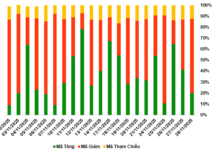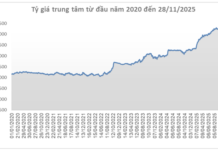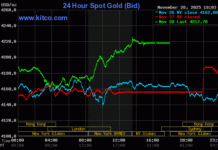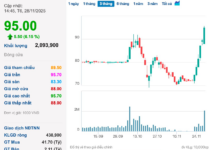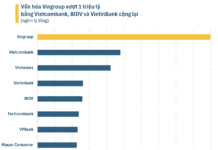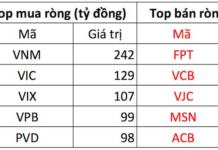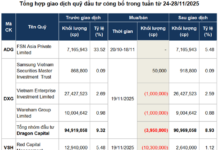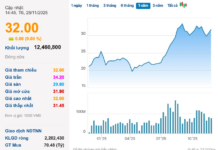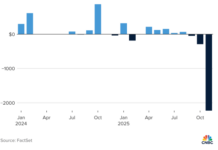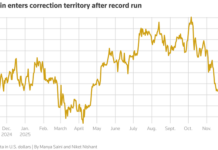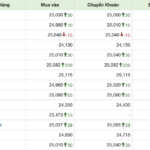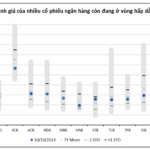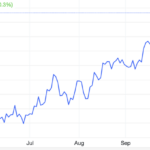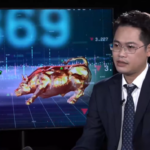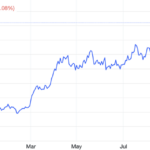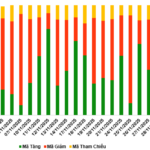On October 25, the State Bank of Vietnam (SBV) announced the central exchange rate at 24,255 VND/USD, a decrease of 5 VND from the previous day. This was the first time the SBV had lowered the central rate after eight consecutive increases.
Multiple Pressures
Commercial banks sold USD at around 25,467 VND/USD, a decrease of about 6 VND compared to the previous day. However, this rate is approaching the peak level recorded in April. Since the beginning of October, the USD rate at commercial banks has increased by approximately 730 VND, or nearly 3%. This is a rapid increase in the exchange rate after a brief period of cooling.
The interbank exchange rate has also strengthened in recent days, reaching the 25,200 VND/USD range, about 1% away from the previous peak in April.
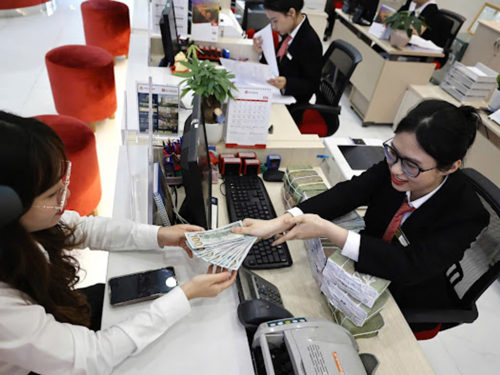
While businesses worry about the rising exchange rate, experts believe this trend is only short-term. Photo: LAM GIANG
According to banks, the exchange rate has increased amid a strong recovery in the global USD index (DXY) in a short period, currently standing at 103.9 points, about 4.1% higher than at the beginning of October. The USD is strengthening as US government bond yields and gold prices reach new highs, creating pressure on domestic rates.
The price of gold reached an all-time high of 2,747 USD/ounce, pushing the domestic gold bar price to 89 million VND/tael, and gold ring prices to a record 89 million VND/tael. Gold bars are being sold sparingly by commercial banks and the SJC Company. Meanwhile, gold rings are becoming scarce as people are not selling them. Analysts say this could trigger a rush to hoard USD for gold smuggling, putting pressure on the VND/USD rate.
However, financial and banking expert Dr. Nguyen Tri Hieu believes that the pressure from gold smuggling is not significant as the amount of USD used for this purpose is not substantial. The main reason for the rising exchange rate is the tense situation in the Middle East, which has increased investors’ confidence in the USD.
Additionally, the demand for importing consumer goods and production materials for export tends to increase towards the end of the year, leading to a surge in USD demand and causing exchange rate shocks.
In response to the rapid increase in the exchange rate, the SBV has reopened the issuance channel for bills to absorb money and ease pressure on the rate. According to Mr. Nguyen Thanh Lam, Director of Analysis of the Individual Customer Division at Maybank Securities Company, in just a few recent sessions, the SBV has issued bills to absorb nearly VND 34,000 billion. This is the first time the SBV has activated money absorption using bills after more than five months of inactivity.
However, the winning interest rates were only at 3.75% (for a 14-day term) and 4% (for a 28-day term), indicating the SBV’s orientation towards monetary easing. The SBV has not shown any moves to sell USD for direct market intervention. “The exchange rate will rebound in the short term, but as the Fed has started a rate cut cycle, this pressure will not last long. The VND will soon stabilize against the USD, and the SBV will maintain its loose monetary policy to support economic growth,” said Mr. Nguyen Thanh Lam.
Costs creep up due to exchange rate movements
According to Mr. Tran Van Truong, Director of Hoang Gia International Seafood Trading Company (Ho Chi Minh City), which specializes in importing high-end seafood, the rising USD rate will undoubtedly affect Tet holiday business by increasing capital costs.
For seafood, the seasonality of supply significantly influences pricing. If it is out of season, prices can be 20-30% higher than usual. “It is expected that this Tet, the King Crab from Russia, imported from South Korea, and the Korean flounder will be more expensive due to the double impact of exchange rates and off-season supply,” said Mr. Truong.
Mr. Truong also shared that the flight route from Europe to Vietnam has stabilized after being affected by the military conflict in the Middle East. As a result, brown crab and Boston lobster from Ireland are still available. “This year, we predict a growth of 5-10% during the Tet season. However, as we import fresh seafood weekly and continue to import close to Tet, there are still many variables. The most important thing is to be flexible and responsive,” Mr. Truong added.
Mr. Nguyen Anh Tuan, Deputy General Director of Colusa-Miliket Foodstuff Joint Stock Company, said that the company’s purchasing department has just reported an increase in the prices of raw materials, especially the two main ingredients of wheat flour and frying oil. The reason for the price increase is the impact of political conflicts in some regions of the world and unfavorable agricultural production conditions. Notably, since the second quarter of 2024, the prices of these raw materials have increased sharply, forcing the company to raise the selling prices of some products by 3-5%. However, as consumers tightened their belts in 2024, the company had to implement support programs for distributors and dealers alongside price adjustments. “The volatile exchange rate will increase the pressure on input material prices for my company and other companies producing foodstuffs and beverages that use imported raw materials,” said Mr. Tuan.
Meanwhile, Mr. Francis Lee, Representative of the Washington Apple Association in Vietnam, said that the exchange rate movement does not significantly affect the Tet season for US apples. The reason is that the exchange rate fluctuation is not too large, and ocean freight rates have decreased, reducing costs for importers. “Currently, importers are well prepared to serve the Tet season with a volume of several hundred containers,” said Mr. Lee.
Mr. Lee also shared that Vietnam imports apples from many countries, but US apples are still favored by Vietnamese consumers, even though they are slightly more expensive. During the Tet holiday, consumers prefer apples with beautiful red colors, and US green apples are also popular for their fresh and standard green color.
From an expert’s perspective, Dr. Nguyen Tri Hieu analyzed that the rising exchange rate would increase commodity prices, affecting inflation and having a negative impact on the macro-economy. However, from now until the end of the year, the Fed may cut interest rates further, which could slow down the appreciation of the USD. At the same time, foreign currency supply from remittances and FDI disbursements will be abundant. As a result, the exchange rate may stabilize, helping Vietnam reduce commodity price pressures and control inflation.
Exchange Rate Fluctuations are Temporary
Mr. Ngo Dang Khoa, Head of Forex, Capital Markets, and Securities Services, HSBC Vietnam, said HSBC maintains its forecast of 24,800 VND/USD by the end of this year. However, at a certain point in time, the exchange rate will fluctuate due to input factors. The market will also experience more fluctuations towards the year-end, with high payment demands, the US election, or geopolitical tensions in the Middle East.
However, the pressure on the exchange rate is more temporary, and the overall supply in the market is not overly concerning as Vietnam still has a net inflow of USD from trade deficits, remittances, and FDI disbursements. “The SBV’s management has been quite good, both technically and diplomatically. Globally, other currencies have fluctuated wildly, while the VND’s movement has been slow and steady, unlike the Japanese yen, which can change by 5-7% in a day,” said Mr. Ngo Dang Khoa.
Mr. Tim Leelahaphan, Vietnam and Thailand Economist, Standard Chartered Bank, also forecasted that the Fed’s interest rate cuts would weaken the USD in the next few quarters. As a result, the exchange rate is expected to cool down to around 24,500 VND by the end of this year and about 24,300 VONG/USD by mid-next year.
“Undervalued Banking Stocks: Unlocking the Potential of High-Growth Financial Powerhouses”
We recommend investing in bank stocks for a medium to long-term vision, even if short-term profit growth prospects don’t present many surprises. Banks possess robust and sustainable growth drivers and are currently undervalued in the market; these include major players such as ACB, CTG, MBB, TCB, and VPB.
Gold Prices Plunge as Fed Rate Cut Hopes Fade
Investors cautiously awaited the Fed’s release of the minutes from its September meeting, along with the latest inflation data from the U.S. Labor Department.

